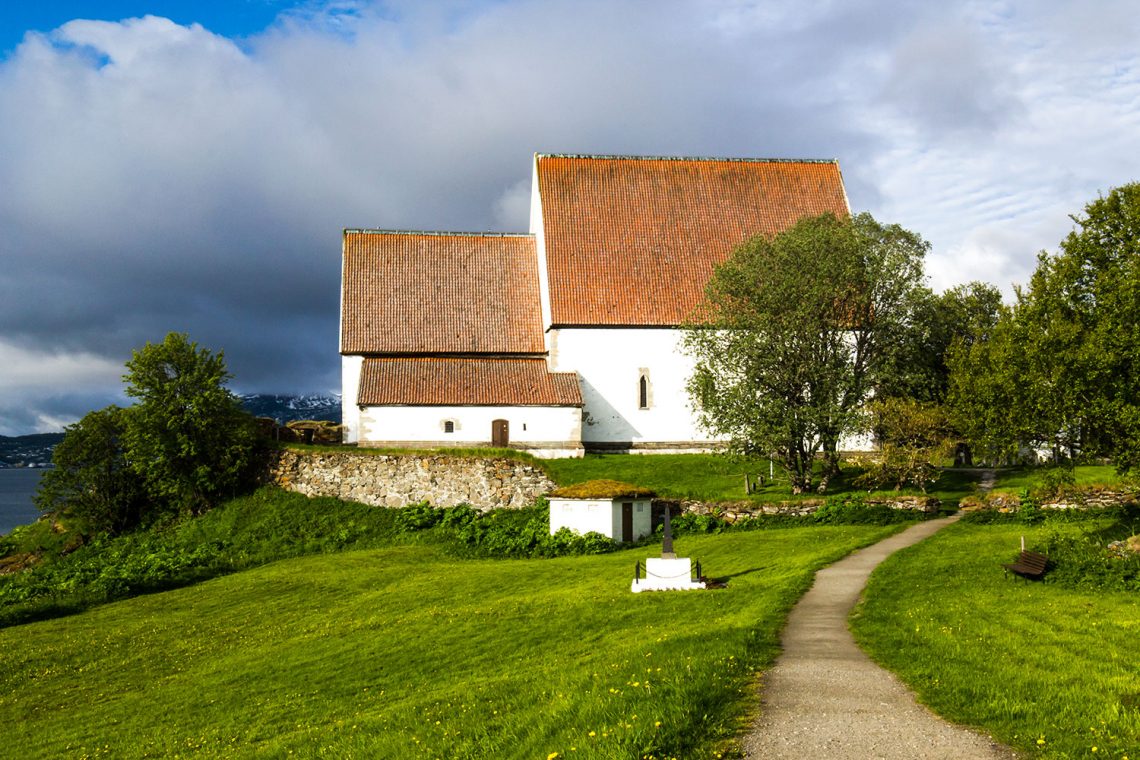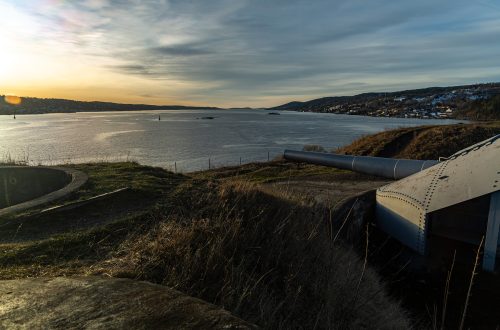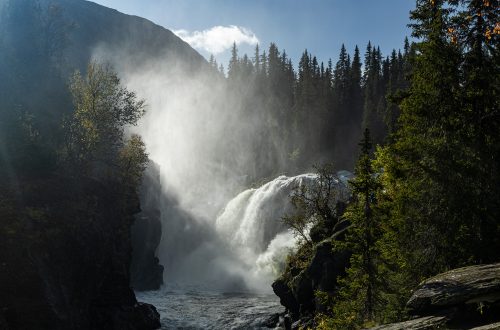
Kościół Trondenes
Kościół Trondenes znajdujący się poza centrum Harstad w północnej części miasta to budowla wzniesiona w XIII wieku i jest uważana za najbardziej na północ położonym średniowiecznym kamiennym kościołem w Norwegii. Dodatkowo, to najbardziej wysunięty na północ średniowieczny budynek, który przetrwał do naszych czasów. Zgodnie z danymi z Wikipedii oraz z tablic informacyjnych przed kościołem, wnętrze świątyni jest bogato zdobione. Trzy gotyckie tryptyki, barokowa ambona, organy z XVIII wieku czy pozostałości średniowiecznych fresków to atrakcje czekające na odwiedzających. Jako że świątynia położona została tuż przy brzegu morza, w przeszłości stanowiła główne centrum kościoła w północnej Norwegii. Pod jej sklepieniem rozwieszono żagiel, którego pozostałości obecnie można oglądać w Centrum Historycznym Trondenes, dwie minuty spacerkiem od samego kościoła.
Nie wiadomo dokładnie kiedy kościół w Trondenes został zbudowany. Źródła podają jednak, że powstał w miejscu co najmniej dwóch innych świątyń. Pierwsza była najprawdopodobniej typowym drewnianym kościołem słupowym wzniesionym w 1114 roku przez króla Øysteina Magnussona. Pozostałości późniejszej, murowanej świątyni istnieją do dziś w postaci kamiennego muru i szczątków dwóch wież od strony morza.
Na cmentarzu otaczającym kościół znajduje się dzwonnica. Kiedyś znajdujące się w niej dzwony wisiały na wieży, ta jednak została zburzona i nie dotrwała do naszych czasów.
Do Trondenes dotarłem wczesnym rankiem, w okolicach godziny 7.00. Nie było szans, abym mógł wejść do środka i przyjrzeć się dekoracjom wewnątrz. Centrum Historyczne również było jeszcze zamknięte, toteż pozostało mi jedynie rozejrzeć się po terenie wokół kościoła.





I choć wydawałoby się, że historia kościoła to głównie czasy średniowiecza, ma on w zanadrzu jeszcze jedną, znacznie współczesną i mroczną opowieść. Zaraz za świątynią, po wschodniej jego stronie można natknąć się na pomnik i kilka tablic informacyjnych a także pozostałości kilku budowli. W latach 1941 – 1945 gdy Norwegia znajdowała się pod okupacją niemiecką, do Trondenes zwożono jeńców radzieckich i wykorzystywano ich do pracy przy ufortyfikowaniu wybrzeża. Szacuje się, że mogło tu trafić około 100 000 więźniów, z czego 13 700 zmarło z powodu zimna, głodu, chorób i fizycznego wycieńczenia. Radzieccy jeńcy z Armii Czerwonej byli wykorzystywani do prac przy wznoszeniu budynków, fundamentów pod działa, budowaniu dróg, w transporcie materiałów budowlanych czy przy odśnieżaniu.
Obóz jeniecki w Trondenes był jednym z największych w całej Norwegii. Jego lokalizację wybrano nieprzypadkowo, bowiem to właśnie tutaj powstawała Forteca Hitlera, Bateria Theo, część wielkiego Wału Atlantyckiego, rozciągającego się od Zatoki Biskajskiej aż do Oceanu Arktycznego. Było to pasmo umocnień, które miało chronić podbitą przez Niemców Europę przed inwazją aliantów. Półwysep Trondenes był jednym z 300 lokacji, gdzie wzniesiono umocnienia obronne na terenie Norwegii w latach 1942 – 1943.
Ustawiono tutaj cztery ogromne działa (40,6cm SK C/34) zwane działami Adolfa. Wyprodukowane przez zakłady Krupp’a miały być zainstalowane na pancernikach klasy H oraz J, ale te nigdy nie zostały ukończone i ostatecznie działa te przeznaczono do umocnień Wału Atlantyckiego. Jedna z tych armat jest dziś dostępna zwiedzającym, jednak z uwagi, że znajduje się ona na terenie czynnej norweskiej bazy wojskowej, należy wcześniej umówić się na wizytę. Ciekawostką jest fakt, że trzy takie działa zamontowano w Polsce, na Półwyspie Helskim w 1940 roku. W 1941 roku zdemontowano je i przewieziono do Francji w okolice Sangatte, skąd ostrzeliwano angielski Dover.













The Trondenes Church, located outside the center of Harstad in the northern part of town is a structure built in the 13th century and it is considered the northernmost medieval stone church in Norway. Additionally, it is the northernmost medieval building that has survived to our times. According to Wikipedia and information boards in front of the church, the interior is richly decorated. Three gothic triptychs, a baroque pulpit, an 18th-century organ and the remains of medieval frescoes are attractions waiting for visitors. As the temple was situated right on the seashore, in the past it was the main religious center in northern Norway. A sail was hung under its ceiling, the remains of which can now be seen in the Trondenes Historical Center, a two-minute walk from the church itself.
It is not known exactly when the church in Trondenes was built. However, sources say that it was built on the site of at least two other temples. The first was most likely a typical wooden stave church erected in 1114 by King Øystein Magnusson. The remains of the later stone temple still exist today in the form of a stone wall and the remains of two towers facing the sea.
There is a bell tower in the cemetery that surrounds the church. Once there were bells hung on the church tower, but this one was demolished and has not survived to our times.
I got to Trondenes early in the morning, around 7.00. There was no way I could go inside and look at the decorations there. The Historic Center was also closed so early, so all I could to do was look around the church.
And although it would seem that the history of the church is mainly from the Middle Ages, it has another, much modern and dark story up its sleeve. Right behind the temple, on its eastern side, you can find a monument and several information boards as well as the remains of several buildings. In the years 1941 – 1945, when Norway was under German occupation, Soviet prisoners of war were brought to Trondenes and used to work on fortifying the coast. It is estimated that around 100,000 prisoners may have been sent here, 13,700 of whom died of cold, hunger, disease and physical exhaustion. Soviet prisioners from the Red Army were used to erect buildings, foundations for cannons, build roads, transport construction materials and remove snow.
The Trondenes prisioners camp was one of the largest in Norway. Its location was chosen on special purpose, because it was here that Hitler’s Fortress, Theo Battery, part of the great Atlantic Wall, stretching from the Bay of Biscay to the Arctic Ocean, was built. Atlantic Wall was a range of fortifications that was to protect the German-conquered Europe from the Allied invasion. The Trondenes Peninsula was one of 300 locations where defensive fortifications were erected in Norway in 1942-1943.
Four huge guns (40.6cm SK C / 34) called Adolf’s cannons were set up here. Manufactured by Krupp’s factory, they were supposed to be installed on H and J-class battleships, but these were never completed and finally the guns were assigned to the fortifications of the Atlantic Wall. One of these cannons is available to visitors today, but due to the fact that it is located on the area of an active Norwegian military base, you must make an appointment in advance. An interesting fact is that three cannons this type were originally installed in Poland, on the Hel Peninsula in 1940. In 1941, they were dismantled and transported to France near Sangatte, from where the English Dover was shelled.




